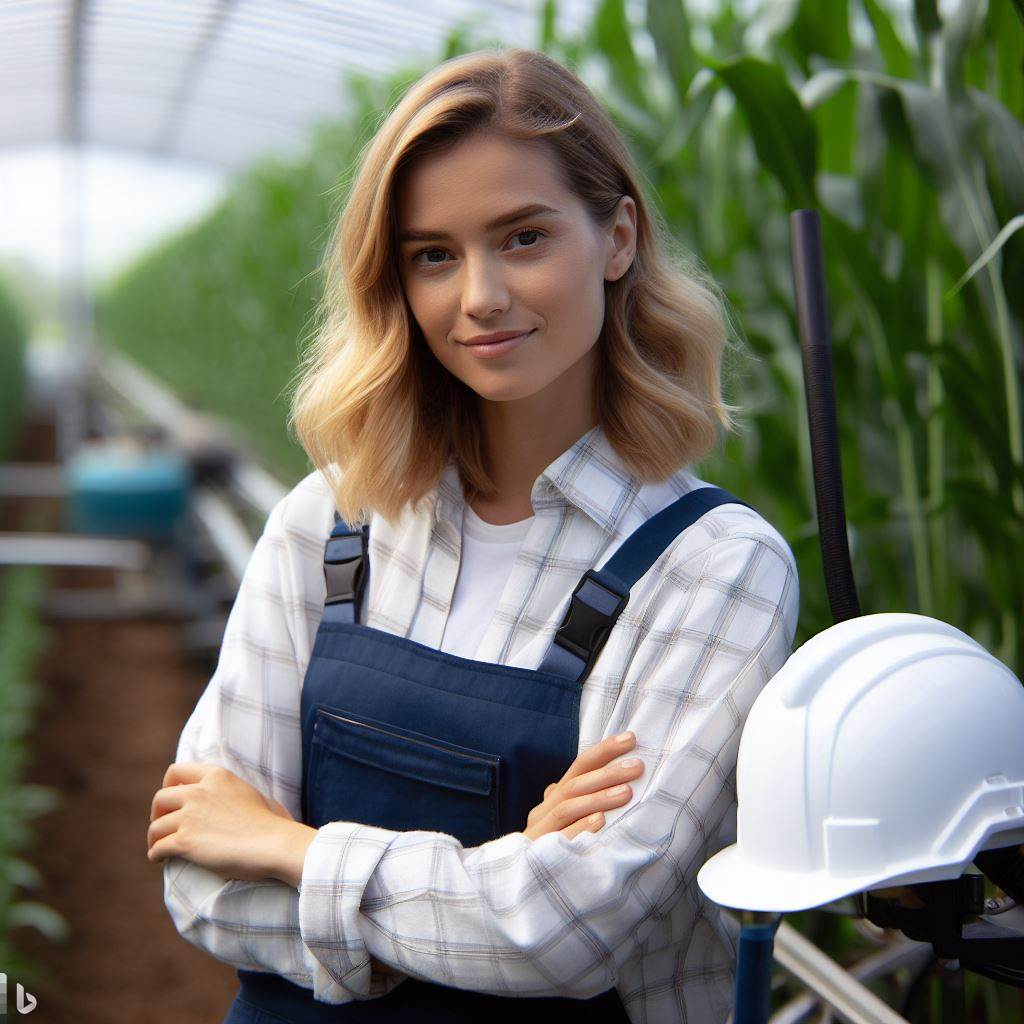Introduction
The specter of climate change casts a growing shadow, manifesting through shifting weather patterns, intensified natural disasters.
And ecological uncertainties, all of which have a profound impact on US agriculture.
The significance of agricultural engineering in the United States becomes increasingly apparent as it navigates this evolving terrain.
Agricultural engineers are at the forefront of developing and implementing innovative solutions to address the complex challenges posed by climate change.
The purpose of this blog post is to embark on a comprehensive exploration of the intricate relationship between climate change and US agricultural engineering.
It will dissect the challenges that agricultural engineers face, as well as the creative and resourceful ways they adapt and mitigate the effects of climate change.
This journey offers insights into the innovative solutions, cutting-edge technologies.
And sustainable practices employed by agricultural engineers as they shape a resilient and climate-conscious future for agriculture in the United States.
Overview of US Agricultural Engineering
Agricultural engineering plays a crucial role in modern farming practices, integrating technology and science to improve agricultural systems.
It involves designing, developing, and applying engineering principles to solve problems in agriculture, creating sustainable and efficient solutions.
Agricultural engineering and its role in modern farming practices
Agricultural engineering is the application of engineering principles and technology to agriculture. It aims to improve farming methods, increase production, and minimize environmental impacts.
It involves designing machinery, developing irrigation systems, and creating efficient farming practices.
The major areas of focus within the field
Within agricultural engineering, there are various areas of focus.
These include farm machinery and power systems, agricultural structures and buildings, soil and water conservation, irrigation and drainage systems, precision agriculture, and food and bioprocess engineering.
Farm machinery and power systems involve the design and development of equipment used in farming operations, such as tractors, harvesters, and irrigation systems.
These machines help increase productivity and streamline farming processes.
Agricultural structures and buildings encompass the design and construction of facilities used in farming, such as barns, storage structures, and greenhouses.
These structures provide suitable environments for livestock, crop storage, and controlled cultivation.
Soil and water conservation focuses on preventing soil erosion and degradation, as well as managing water resources efficiently.
Methods like terracing, contour plowing, and conservation tillage help maintain soil fertility and prevent water runoff.
Irrigation and drainage systems ensure proper water supply to crops and prevent waterlogging or excess moisture.
These systems optimize water usage, maximizing crop yields and reducing water wastage.
Precision agriculture integrates technology like GPS, sensors, and drones to enhance farming efficiency.
It enables farmers to monitor crop health, apply fertilizers and pesticides accurately, and use resources more effectively, leading to higher productivity.
Food and bioprocess engineering involves developing technologies and processes for food production, preservation, and processing.
This field ensures the safe and efficient handling, storage, and distribution of agricultural products, supporting the food industry.
The significance of US agricultural engineering on the country’s food production and economy
US agricultural engineering plays a vital role in the country’s food production and economy.
It enables farmers to adopt advanced techniques and technologies, leading to increased agricultural productivity and efficiency.
Through the development of innovative machinery and systems, agricultural engineering helps farmers save time and labor while maximizing crop yields.
This not only ensures a stable food supply but also contributes to the economic growth of the agricultural sector.
Furthermore, agricultural engineering promotes sustainable farming practices that minimize negative environmental impacts.
By implementing efficient irrigation systems, soil conservation methods, and precision agriculture, the field helps reduce water usage, soil erosion, and chemical waste.
The growth of agricultural engineering also drives technological advancements in other sectors.
It stimulates research and development, leading to improvements in engineering, automation, and data analysis, which have applications beyond agriculture.
Basically, US agricultural engineering plays a critical role in modern agriculture by integrating engineering principles and technology into farming practices.
By focusing on areas such as machinery, structures, conservation, and precision, it enhances productivity, sustainability, and economic growth, ensuring a secure food supply for the nation.
Read: US Breeding Regulations: What New Breeders Must Know
Climate Change and its Effects on US Agriculture
Overview of Climate Change and its Causes
Climate change refers to long-term changes in temperature, precipitation, wind patterns, and other aspects of the Earth’s climate system.
It is primarily caused by human activities, particularly the burning of fossil fuels, deforestation, and industrial processes.
Specific Ways Climate Change Affects the Agricultural Sector in the US
Changes in temperature and precipitation patterns
Climate change disrupts normal weather patterns, leading to irregular rainfalls, heatwaves, and changing growing seasons, which affects crop growth and productivity.
Transform Your Career Today
Unlock a personalized career strategy that drives real results. Get tailored advice and a roadmap designed just for you.
Start NowIncreased frequency and intensity of extreme weather events, such as droughts and floods
Rising temperatures contribute to more frequent and severe droughts, floods, and storms, causing significant damage to crops, livestock, and infrastructure.
Shifts in pest and disease patterns
Climate change alters the geographical distribution and behavior of pests and diseases, posing new challenges for farmers in managing them effectively.
Potential Consequences of These Effects on Crops, Livestock, and Farm Operations
Decreased crop yields
Unpredictable weather patterns and increased pest pressure can lead to reduced crop yields, impacting food production and economic stability in the agricultural sector.
Increased susceptibility to pests and diseases
Rising temperatures and altered pest dynamics make crops and livestock more vulnerable to infestations and disease outbreaks, requiring additional resources for prevention and control measures.
Higher production costs and financial burden on farmers
Adapting to climate change demands additional investments in infrastructure, technologies, and sustainable practices, which can increase production costs and put financial strain on farmers.
The impacts of climate change on US agricultural engineering are vast.
To mitigate these effects and ensure agricultural sustainability, there is a pressing need for innovative solutions and adaptive measures.
Agricultural engineers play a crucial role in developing and implementing such strategies.
These professionals can design and optimize irrigation systems that conserve water, enhance soil moisture retention, and minimize runoff.
They can also develop techniques to improve crop resilience to changing climate conditions, such as breeding heat-tolerant varieties or developing precision farming technologies.
Furthermore, agricultural engineers are instrumental in integrating renewable energy sources into farm operations.
Solar panels and wind turbines can help reduce greenhouse gas emissions and provide clean energy for irrigation, machinery, and facilities.
Collaboration between agricultural engineers, farmers, policymakers, and researchers is essential to address the challenges posed by climate change.
It is crucial to develop sustainable and resilient agricultural practices that minimize environmental impacts, enhance productivity, and ensure food security for future generations.
Generally, climate change significantly affects US agriculture by altering weather patterns, increasing the frequency of extreme events, and disrupting pest and disease dynamics.
These changes have profound consequences for crop yields, livestock health, and farmers’ financial stability.
Agricultural engineers must continue to develop innovative solutions to adapt and mitigate the effects of climate change, ensuring a sustainable and resilient agricultural sector for the future.
Read: Financial Prospects of Animal Breeding in the USA
The Role of Agricultural Engineers in Addressing Climate Change Challenges
Contribution of Agricultural Engineers to Climate Change Mitigation and Adaptation Strategies
Agricultural engineers play a crucial role in mitigating and adapting to the challenges posed by climate change.
Examples of Engineering Solutions in Response to Climate Change Effects
- Developing drought-resistant crop varieties: Agricultural engineers work on breeding new crop varieties that can thrive in water-limited conditions.
- Designing precision irrigation systems: Engineers develop efficient irrigation technologies that minimize water wastage and optimize crop water use.
- Implementing sustainable farming practices: Agricultural engineers promote and design sustainable farming techniques that reduce greenhouse gas emissions and improve resource efficiency.
Challenges and Limitations Faced by Agricultural Engineers in Tackling Climate Change
Despite their efforts, agricultural engineers face several challenges and limitations in addressing climate change.
Limited funding and resources
Agricultural engineering research and implementation of climate change solutions require significant financial investments.
Uncertain regulatory environment
Changing regulations and policies create uncertainties for agricultural engineers, making long-term planning and implementation difficult.
Complex and diverse agricultural systems
Each agricultural system differs, and developing solutions that are universally applicable becomes a challenge for engineers.
Balancing social, economic, and environmental factors
Agricultural engineers must consider the economic viability, social acceptance, and environmental impact of their solutions.
Technological limitations
Limited availability and affordability of advanced technologies pose barriers to implementing engineering solutions.
Lack of awareness and outreach
Educating farmers and stakeholders about the importance and benefits of engineering solutions is crucial but often lacks adequate support.
Showcase Your Business Today
Reach thousands of readers actively exploring professional services. Publish your business profile and grow your audience now.
Publish NowIn the end, agricultural engineers play a pivotal role in addressing the challenges posed by climate change in the field of agriculture.
Their contributions to climate change mitigation and adaptation strategies are significant.
Through the development of drought-resistant crop varieties, precision irrigation systems, and sustainable farming practices, engineers provide concrete solutions to climate change effects.
However, they also face challenges such as limited funding, regulatory uncertainties, complex agricultural systems, balancing multiple factors, technological limitations, and lack of awareness.
Overcoming these challenges will require increased support, collaboration, and investment in agricultural engineering research and implementation.
Read: Ethical Practices for Animal Breeders: US Standards

Collaboration and Innovation in US Agricultural Engineering
The need for interdisciplinary collaboration to address climate change challenges
- Climate change poses numerous challenges to US agricultural engineering.
- To effectively tackle these challenges, interdisciplinary collaboration is essential.
- Collaboration brings together diverse expertise and perspectives to find innovative solutions.
- Agricultural engineers can work with scientists, policymakers, and farmers to address climate change.
- By working together, professionals from different fields can merge their knowledge and skills.
- This collaboration helps in developing comprehensive approaches to combat climate change impacts.
- The integration of various disciplines ensures a more holistic understanding of climate change.
- Cooperative efforts foster the development of sustainable agricultural practices resilient to climate change.
The importance of partnerships between agricultural engineers, scientists, policymakers, and farmers
- Partnerships between agricultural engineers, scientists, policymakers, and farmers are crucial.
- Agricultural engineers bring technical expertise and engineering solutions to the table.
- Scientists contribute valuable research and knowledge about climate change and its impacts.
- Policymakers create an enabling environment to implement sustainable agricultural practices.
- Farmers offer practical experience and firsthand insights into the challenges they face.
- Collaborative partnerships bridge the gap between scientific research and on-field implementation.
- Effective communication between these stakeholders ensures relevant and effective solutions.
- Partnerships facilitate the dissemination and adoption of innovative technologies and practices.
Ongoing research and innovations in the field of agricultural engineering related to climate change
- Ongoing research in agricultural engineering focuses on climate change adaptation and mitigation.
- Innovative technologies are being developed to optimize resource efficiency and reduce emissions.
- Precision agriculture techniques enable farmers to monitor and manage their crops more effectively.
- Water management innovations help farmers cope with changing precipitation patterns.
- Advanced sensor networks and data analytics improve decision-making and resource allocation.
- Engineering solutions are being developed to protect crops from extreme weather events.
- Renewable energy technologies are integrated into agricultural systems to reduce greenhouse gas emissions.
- Ongoing innovations increase the resilience and sustainability of agriculture in the face of climate change.
Ultimately, collaboration and innovation are paramount in US agricultural engineering. Interdisciplinary collaboration ensures a comprehensive approach to address climate change.
Partnerships between agricultural engineers, scientists, policymakers, and farmers are vital. Ongoing research and innovations in agricultural engineering contribute to climate change adaptation.
By harnessing collaboration and innovation, we can build a more sustainable and resilient agricultural sector.
Read: Day in the Life: Following a US Animal Breeder
Conclusion
Agricultural engineering in the US is undoubtedly facing significant challenges due to the impact of climate change.
Throughout this blog post, we have highlighted several important points:
- Climate change is causing a shift in weather patterns, which directly affects agricultural production.
- Agricultural engineers play a crucial role in developing innovative solutions to mitigate the effects of climate change.
- Adopting sustainable agricultural practices is essential for the long-term resilience of the industry.
- Technology advancements can assist agricultural engineers in creating efficient and adaptable systems.
Considering the impact of climate change on US agricultural engineering is of utmost significance.
As the industry strives to overcome the challenges posed by a changing climate, it must embrace the urgency to adapt and innovate.
Only by acknowledging this reality can we ensure the sustainability and future success of our agricultural systems.
We encourage our readers to remain informed about climate change’s implications on agriculture and its engineering practices.
By staying up to date with the latest research and advancements, we can collectively support and promote sustainable agricultural practices.
The resilience of US agricultural engineering lies not only in the hands of professionals but also in the collective efforts of society.
Let us actively work together to build a more sustainable future for our agricultural systems, where climate change is seen as an integral consideration.
[E-Books for Sale]
The Big Book of 500 High-Paying Jobs in America: Unlock Your Earning Potential
$19.99 • 500 High-Paying Jobs • 330 pages
Explore 500 high-paying jobs in America and learn how to boost your career, earn more, and achieve success!
See All 500 High-Paying Jobs of this E-Book
1001 Professions Without a Degree: High-Paying American Jobs You Can Start Now
$19.99 • 1001 Professions Without a Degree • 174 pages
Discover 1001 high-paying jobs without a degree! Unlock career tips, skills, and success strategies for just $19.99!




